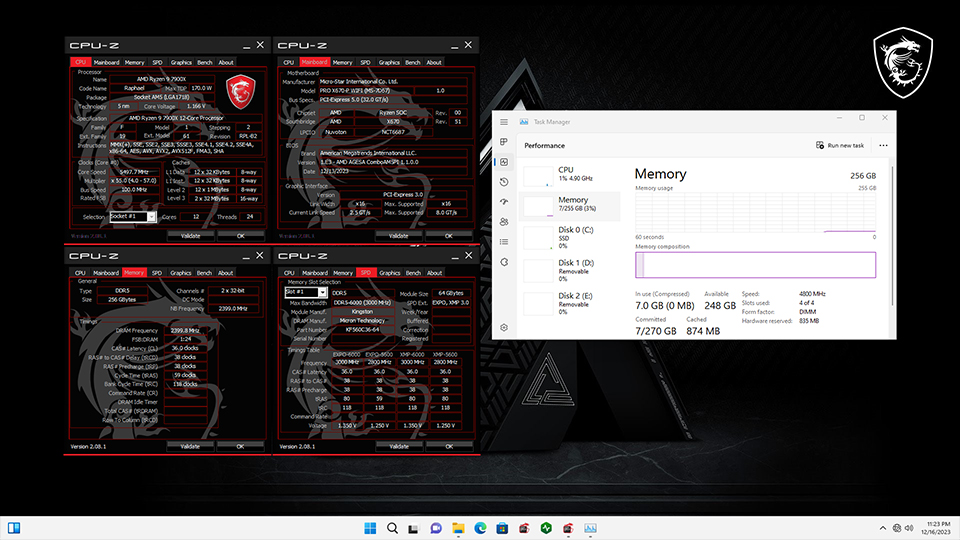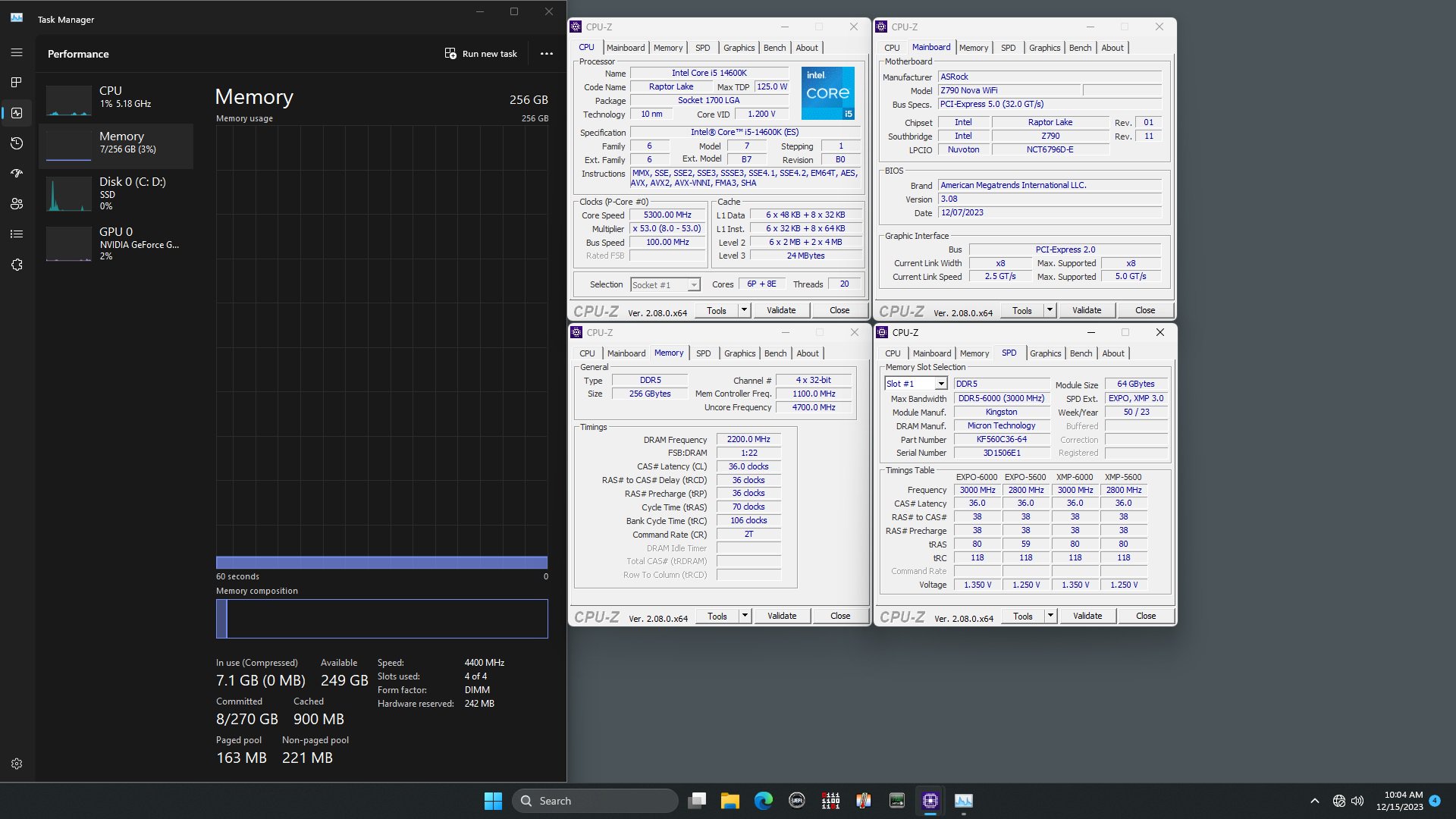New desktop PC chips now support an incredible 256GB of memory — ASRock and MSI update DDR5 support on Intel Z790 and AMD X670E motherboards
Support made possible using Micron's higher density technology originally made for LPDDR5X Mobile Memory Chips

ASRock and MSI announced they now support higher capacity 64GB DDR5 RAMs on each DIMM slot, allowing up to 256GB on four-slot and 128GB on two-slot motherboards. ASRock also announced it can do the same.
MSI didn't reveal which of its motherboards includes this support. The screenshot from MSI shows CPU-Z results using the PRO X670-P WIFI motherboard. But ASRock showed its X670E-Taichi and the Z790 Nova WiFi supporting 64GB DDR5 per DIMM slot. What's interesting is that ASRock is showing the AMD Ryzen 7 8700G APU with its X670E motherboard.



Both motherboard makers use the 64GB x 4 Kingston Fury Renegade KF560C36-64 memory kits with DDR5 chips made by Micron. We aren't sure why MSI couldn't provide a full-size screenshot, but ASROCK provided screenshots showing the support on both chipset platforms. These kits support EXPO and XMP 3.0 profiles, which support up to 6000 MT/s with 36-38-38 latency at 1.350v.
This was made possible by Micron and its 1-Beta node, which provides higher performance, increased bit density, and better power efficiency. This new tech was originally designed for the LPDDR5X mobile chips. It is likely anyone making DDR5 rams with Micron chips made from 1-Beta nodes should be able to provide higher-capacity memory sticks.
Though MSI and ASRock were the first to make the announcement, it is safe to say other motherboard makers with AMD X670E and Z790 chipsets should be able to support 64GB-per-stick DDR5 kits, which for now is made possible by Micron. This is great for those with a dual-DIMM slot mini-ITX motherboard using these chipsets who want higher capacity RAMs. It is uncertain if this support will extend to X670 motherboards since the only addition to the X670E is the support for sixteen PCIe 5.0 lanes via the Ryzen 7000 series CPUs.
Get Tom's Hardware's best news and in-depth reviews, straight to your inbox.

Roshan Ashraf Shaikh has been in the Indian PC hardware community since the early 2000s and has been building PCs, contributing to many Indian tech forums, & blogs. He operated Hardware BBQ for 11 years and wrote news for eTeknix & TweakTown before joining Tom's Hardware team. Besides tech, he is interested in fighting games, movies, anime, and mechanical watches.
-
bit_user I'm not surprised.Reply
It stands to reason that if they supported 192 GB, then 256 should be possible. The ultimate limitation is usually around how many physical bits are exposed by the memory controller, and you can't reach 192 GB if you can't also reach 256 GB. -
brandonjclark Reply
Because to reach 192 you had to already support it's higher, divisible amount, 256?bit_user said:I'm not surprised.
It stands to reason that if they supported 192 GB, then 256 should be possible. The ultimate limitation is usually around how many physical bits are exposed by the memory controller, and you can't reach 192 GB if you can't also reach 256 GB. -
JarredWaltonGPU Reply
Correct. The memory address space for the chipset has to be at least 38-bit in order to support either 192GB or 256GB. That's probably the limit, though. I strongly doubt anyone would do a 39-bit address space, with 40-bit being the next likely step. Not that it couldn't be done... but it would be odd. (I'll show myself out now. :))brandonjclark said:Because to reach 192 you had to already support it's higher, divisible amount, 256? -
bit_user Reply
It should be possible to discover this, but I'm not sure where to look. There's no reason why 39-bit would be strange... it really just has to do with how much memory Intel thought they wanted to be able to support, on the platform. It's only datapaths that you'd really like to be a nice power of 2.JarredWaltonGPU said:I strongly doubt anyone would do a 39-bit address space, with 40-bit being the next likely step.
I'll just say I'm glad we finally pushed past 128 GB, not that I need even that much. However, that has been the limit on mainstream boards for a while, IIRC. -
JarredWaltonGPU Reply
Mostly 39-bit would be strange because it's just one bit more than the presumably current 38-bit space. (Actually, it might already be 40-bit, just because that seems a nice stepping stone. Whatever.)bit_user said:It should be possible to discover this, but I'm not sure where to look. There's no reason why 39-bit would be strange... it really just has to do with how much memory Intel thought they wanted to be able to support, on the platform. It's only datapaths that you'd really like to be a nice power of 2.
I'll just say I'm glad we finally pushed past 128 GB, not that I need even that much. However, that has been the limit on mainstream boards for a while, IIRC.
I think if a company is going to rework things to support more RAM, it would do more than a single bit step is all. So it's not that it can't be done, but we're not at the stage where generational improvements are so small that the idea of adding a single bit width to an interface or address space might be the right approach. In another ten or twenty years, maybe that starts to become the norm. -
husker Someday, all this memory will come in handy when we have a fully resident AI incorporated into games, which lives in a 128 GB memory space and uses, say, the first 32 cores in a run-of-the-mill 64 core gaming CPU. Let's go!Reply -
bit_user Reply
I'm telling you: nothing is gained by using "nice, round numbers". You're too used to thinking of bits in arithmetic and datapaths. Addressing works differently.JarredWaltonGPU said:Mostly 39-bit would be strange because it's just one bit more than the presumably current 38-bit space. (Actually, it might already be 40-bit, just because that seems a nice stepping stone. Whatever.)
It needn't be a "rework" - it's just an aspect of designing their memory controller and socket specification. I believe each bit has a cost.JarredWaltonGPU said:I think if a company is going to rework things to support more RAM, it would do more than a single bit step is all.
I don't know enough about DDR5 to understand what implications it might have at a physical or timing level, however I did try looking at the System Memory Interface definition, in Intel's datasheets. They do reference multiplexing the address, and I could see how selecting from more banks might add latency.
Not only that, but they have market segmentation to consider. -
Co BIY The logic of market segmentation and marketing is often not the same as the logic of ... logic.Reply -
atomicWAR I was happy to see this. I had wanted 128GB via two channels in my wife's and my respective rigs but it was a no go when I built them. Maybe when we upgrade to Zen 5 (or ideally 6 if it does indeed hit AM5) as I already frequently hit 32GB+ in my everyday usage though when gaming I obviously need to free up some resources. In an ideal world I could have my billion tabs open watching a show on one monitor and gaming on the other. My wife maybe less so as she isn't the resource hog I am lol.Reply
End of the day this is good news for all even if this was pretty much expected lag when I and others bought AM5 till they supported 256GB. They did the same doubling on AM4 from 64->128GB sometime into it lifecycle. -
newtechldtech Hopefully some motherboard makers will use oly 2 dimms and free more space on the motherboard after this ...Reply
Also this is good news for itx builds ...